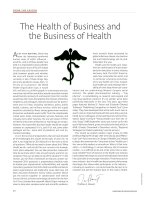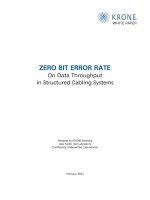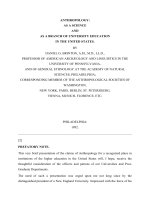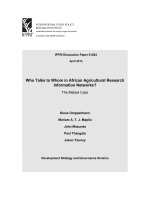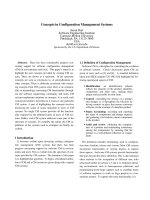Protecting Data Privacy in Health Services Research pptx
Bạn đang xem bản rút gọn của tài liệu. Xem và tải ngay bản đầy đủ của tài liệu tại đây (1.74 MB, 209 trang )
Visit the
National Academies Press online, the authoritative source for all books from the
National Academy of Sciences, the National Academy of Engineering, the Institute of
Medicine, and the National Research Council:
• Download hundreds of free books in PDF
• Read thousands of books online, free
• Sign up to be notified when new books are published
• Purchase printed books
• Purchase PDFs
• Explore with our innovative research tools
Thank you for downloading this free PDF. If you have comments, questions or just want
more information about the books published by the National Academies Press, you may
contact our customer service department toll-free at 888-624-8373,
visit us online, or
send an email to
This free book plus thousands more books are available at
.
Copyright © National Academy of Sciences. Permission is granted for this material to be
shared for noncommercial, educational purposes, provided that this notice appears on the
reproduced materials, the Web address of the online, full authoritative version is retained,
and copies are not altered. To disseminate otherwise or to republish requires written
permission from the National Academies Press.
ISBN: 0-309-56486-7, 208 pages, 6 x 9, (2000)
This free PDF was downloaded from:
/>Protecting Data Privacy in Health Services Research
Committee on the Role of Institutional Review Boards in
Health Services Research Data Privacy Protection,
Division of Health Care Services
Protecting Data Privacy
in Health Services
Research
Committee on the Role of Institutional Review Boards in
Health Services Research Data Privacy Protection
Division of Health Care Services
INSTITUTE OF MEDICINE
NATIONAL ACADEMY PRESS
Washington, D.C.
i
About this PDF file: This new digital representation of the original work has been recomposed from XML files created from the original paper book, not from the original
typesetting files. Page breaks are true to the original; line lengths, word breaks, heading styles, and other typesetting-specific formatting, however, cannot be retained,
and some typographic errors may have been accidentally inserted. Please use the print version of this publication as the authoritative version for attribution.
Copyright © National Academy of Sciences. All rights reserved.
Protecting Data Privacy in Health Services Research
/>NATIONAL ACADEMY PRESS 2101 Constitution Avenue, N.W. Washington, DC 20418
NOTICE: The project that is the subject of this report was approved by the Governing Board of the
National Research Council, whose members are drawn from the councils of the National Academy
of Sciences, the National Academy of Engineering, and the Institute of Medicine. The members of
the committee responsible for the report were chosen for their special competences and with regard
for appropriate balance.
Support for this study was provided by The Agency for Healthcare Research and Quality, and
the Office of the Assistant Secretary for Planning and Evaluation, both of the Department of Health
and Human Services (Contract No.282-99-0045, Task Order No.1).
International Standard Book No. 0-309-07187-9
Protecting Data Privacy in Health Services Research is available for sale from the National
Academy Press, 2101 Constitution Avenue, N.W., Box 285, Washington, DC 20055; call (800)
624-6242 or (202) 334-3938 (in the Washington metropolitan area), or visit the NAP's on-line book-
store at www.nap.edu.
The full text of this report is available on line at www.nap.edu.
For more information about the Institute of Medicine, visit the IOM home page at www.iom.edu.
Copyright 2000 by the National Academy of Sciences. All rights reserved.
Printed in the United States of America.
The serpent has been a symbol of long life, healing, and knowledge among almost all cultures
and religions since the beginning of recorded history. The image adopted as a logo-type by the Insti-
tute of Medicine is based on a relief carving from ancient Greece, now held by the Staatliche
Musseen in Berlin.
ii
About this PDF file: This new digital representation of the original work has been recomposed from XML files created from the original paper book, not from the original
typesetting files. Page breaks are true to the original; line lengths, word breaks, heading styles, and other typesetting-specific formatting, however, cannot be retained,
and some typographic errors may have been accidentally inserted. Please use the print version of this publication as the authoritative version for attribution.
Copyright © National Academy of Sciences. All rights reserved.
Protecting Data Privacy in Health Services Research
/>“Knowing is not enough; we must apply.
Willing is not enough; we must do.”
—Goethe
INSTITUTE OF MEDICINE
Shaping the Future for Health
iii
About this PDF file: This new digital representation of the original work has been recomposed from XML files created from the original paper book, not from the original
typesetting files. Page breaks are true to the original; line lengths, word breaks, heading styles, and other typesetting-specific formatting, however, cannot be retained,
and some typographic errors may have been accidentally inserted. Please use the print version of this publication as the authoritative version for attribution.
Copyright © National Academy of Sciences. All rights reserved.
Protecting Data Privacy in Health Services Research
/>The National Academy of Sciences is a private, nonprofit, self-perpetuating
society of distinguished scholars engaged in scientific and engineering
research, dedicated to the furtherance of science and technology and to their
use for the general welfare. Upon the authority of the charter granted to it by
the Congress in 1863, the Academy has a mandate that requires it to advise
the federal government on scientific and technical matters. Dr. Bruce M.
Alberts is president of the National Academy of Sciences.
The National Academy of Engineering was established in 1964, under the
charter of the National Academy of Sciences, as a parallel organization of
outstanding engineers. It is autonomous in its administration and in the
selection of its members, sharing with the National Academy of Sciences the
responsibility for advising the federal government. The National Academy of
Engineering also sponsors engineering programs aimed at meeting national
needs, encourages education and research, and recognizes the superior
achievements of engineers. Dr. William. A. Wulf is president of the National
Academy of Engineering.
The Institute of Medicine was established in 1970 by the National Academy
of Sciences to secure the services of eminent members of appropriate
p
rofessions in the examination of policy matters pertaining to the health of
the public. The Institute acts under the responsibility given to the National
Academy of Sciences by its congressional charter to be an adviser to the
federal government and, upon its own initiative, to identify issues of medical
care, research, and education. Dr. Kenneth I. Shine is president of the
Institute of Medicine.
The National Research Council was organized by the National Academy of
Sciences in 1916 to associate the broad community of science and
technology with the Academy’s purposes of furthering knowledge and
advising the federal government. Functioning in accordance with general
p
olicies determined by the Academy, the Council has become the principal
operating agency of both the National Academy of Sciences and the National
Academy of Engineering in providing services to the government, the public,
and the scientific and engineering communities. The Council is administered
j
ointly by both Academies and the Institute of Medicine. Dr. Bruce M.
Alberts and Dr. William. A. Wulf are chairman and vice chairman,
respectively, of the National Research Council.
www.national-academies.org
iv
About this PDF file: This new digital representation of the original work has been recomposed from XML files created from the original paper book, not from the original
typesetting files. Page breaks are true to the original; line lengths, word breaks, heading styles, and other typesetting-specific formatting, however, cannot be retained,
and some typographic errors may have been accidentally inserted. Please use the print version of this publication as the authoritative version for attribution.
Copyright © National Academy of Sciences. All rights reserved.
Protecting Data Privacy in Health Services Research
/>COMMITTEE ON THE ROLE OF INSTITUTIONAL
REVIEW BOARDS IN HEALTH SERVICES RESEARCH
DATA PRIVACY PROTECTION
BERNARD LO (Chair), Professor of Medicine, Director of Programs in
Medical Ethics University of California San Francisco
ELIZABETH ANDREWS, Director, World Wide Epidemiology, Glaxo
Wellcome
JOHN COLMERS, Executive Director, Maryland Health Care Commission
GEORGE DUNCAN, Professor of Statistics, Heinz School of Public Policy and
Management, Carnegie Mellon University
JANLORI GOLDMAN, Director, Health Privacy Project, Georgetown
University, Institute for Health Care Research and Policy
CRAIG W. HENDRIX, Associate Professor of Medicine, Johns Hopkins
University
MARK C. HORNBROOK, Associate Director, Center for Health Research,
Kaiser Permanente Northwest
LISA IEZZONI, Professor of Medicine, Harvard Medical School, Beth Israel
Deaconess Medical Center, Division of General Medicine and Primary Care
DONALD KORNFELD, Associate Dean Faculty of Medicine, Chairman,
Institutional Review Board, Professor of Psychiatry, Columbia University
College of Physicans and Surgeons, Presbyterian University
ELLIOT STONE, Executive Director and CEO, Massachusetts Health Data
Consortium, Inc.
PETER SZOLOVITS, Professor, Massachusetts Institute of Technology,
Department of Electrical Engineering and Computer Science
ADELE WALLER, Partner, Bell, Boyd & Lloyd, Chicago
Consultants
BARTHA-MARIA KNOPPERS, Professor, Faculty of Law, Senior
Researcher, C.R.D.P., Legal Counsel, McMaster Gervais, University of
Montreal
ROSS A. THOMPSON, Professor, Department of Psychology, University of
Nebraska
Staff
LEE ZWANZIGER, Senior Program Officer
RITA GASKINS, Senior Project Assistant
v
About this PDF file: This new digital representation of the original work has been recomposed from XML files created from the original paper book, not from the original
typesetting files. Page breaks are true to the original; line lengths, word breaks, heading styles, and other typesetting-specific formatting, however, cannot be retained,
and some typographic errors may have been accidentally inserted. Please use the print version of this publication as the authoritative version for attribution.
Copyright © National Academy of Sciences. All rights reserved.
Protecting Data Privacy in Health Services Research
/>BOARD ON HEALTH CARE SERVICES
DON E. DETMER (Chair), Professor of Medical Education in Health
Evaluation Sciences, University of Virginia
BARBARA J. MCNEIL (Vice Chair), Ridley Watts Professor, Department of
Health Care Policy, Harvard Medical School
LINDA AIKEN, Director, Center for Health Outcomes and Policy Research, and
the Claire M. Fagin Leadership Professor of Nursing and Professor of
Sociology, University of Pennsylvania
STUART H. ALTMAN, Sol C. Chaikin Professor of National Health Policy, the
Florence Heller Graduate School for Social Policy, Brandeis University
HARRIS BERMAN, Chairman and Chief Executive Officer, Tufts Health Plan
BRIAN BILES, Chair and Professor, Department of Health Services
Management and Policy, School of Public Health and Health Services, the
George Washington University
CHRISTINE CASSEL, Chairman, Henry L. Schwarz Department of Geriatrics
and Adult Development, and Professor of Geriatrics and Internal Medicine,
Mount Sinai Medical Center
PAUL D. CLAYTON, Medical Informaticist, Intermountain Health Care, Salt
Lake City, Utah
PAUL F. GRINER, Vice President and Director, Center for the Assessment and
Management of Change in Academic Medicine, Association of American
Medical Colleges
RUBY P. HEARN, Senior Vice President, Robert Wood Johnson Foundation
PETER BARTON HUTT, Partner, Covington & Burling, Washington, D.C.
ROBERT L. JOHNSON, Professor of Pediatrics and Clinical Psychiatry, and
Director, Adolescent and Young Adult Medicine, University of Medicine and
Dentistry of New Jersey, New Jersey Medical School
JACQUELINE KOSECOFF, President and Co-Chief Executive Officer,
Protocare
SHEILA T. LEATHERMAN, Executive Vice President, United Healthcare
Corporation, Center for Health Care Policy and Evaluation, Minneapolis
UWE E. REINHARDT, James Madison Professor of Political Economy and
Professor of Economics and Public Affairs, Princeton University
SHOSHANNA SOFAER, Robert P. Luciano Professor of Health Care Policy,
School of Public Affairs, Baruch College
GAIL L. WARDEN, President and Chief Executive Officer, Henry Ford Health
System
JANET M. CORRIGAN, Director, Board on Health Care Services, Institute of
Medicine
vi
About this PDF file: This new digital representation of the original work has been recomposed from XML files created from the original paper book, not from the original
typesetting files. Page breaks are true to the original; line lengths, word breaks, heading styles, and other typesetting-specific formatting, however, cannot be retained,
and some typographic errors may have been accidentally inserted. Please use the print version of this publication as the authoritative version for attribution.
Copyright © National Academy of Sciences. All rights reserved.
Protecting Data Privacy in Health Services Research
/>Preface
Health services research (HSR) exemplifies some of the greatest hopes and
greatest fears for collecting and analyzing computerized personal health
information. Information routinely collected in the course of providing and
paying for health care can be used by researchers to investigate the relative
effectiveness of alternative clinical interventions, of alternative methods of
organizing, delivering, and paying for health care, and of a variety of health care
policies. Such research may improve the effectiveness and efficiency of health
care. For example, HSR has identified significant variation in outcomes of care
for a specific health problem according to the specialty of the clinician, type of
insurance or reimbursement, and gender or ethnicity of the patient. At the same
time, using personal health information for such research raises concerns about
privacy (whether participants should provide the data) and confidentiality (how
the data may be used later). Such concerns are intensified because of public
concerns that confidentiality is being eroded for many types of computerized
personal information, ranging from credit card purchases to addresses on drivers'
licenses. Concerns about maintaining confidentiality of medical information are
particularly important because patients disclose sensitive information to
physicians that they may not tell close relatives and friends, such as information
about their mental health, alcohol and substance abuse, and sexual practices.
Confidentiality of medical information used in HSR is particularly important
because information on many individuals may be analyzed by researchers
without their knowledge or consent. The very power of HSR, to juxtapose
patient-level data from a variety of sources on a large number of patients, also
raises the largest concerns
PREFACE vii
About this PDF file: This new digital representation of the original work has been recomposed from XML files created from the original paper book, not from the original
typesetting files. Page breaks are true to the original; line lengths, word breaks, heading styles, and other typesetting-specific formatting, however, cannot be retained,
and some typographic errors may have been accidentally inserted. Please use the print version of this publication as the authoritative version for attribution.
Copyright © National Academy of Sciences. All rights reserved.
Protecting Data Privacy in Health Services Research
/>about confidentiality. It is often not feasible to obtain consent from every patient
in a large population to be studied. Even if consent were possible to obtain, the
requirement of consent would likely lead to bias and invalid findings, because
those who opt out might differ systematically from those giving consent. Thus,
for important HSR to proceed, it is important that the privacy and confidentiality
of subjects be adequately protected.
IRBs play a key role in protecting the subjects of research. This IOM
committee was charged with identifing current and best practices of IRBs that
review HSR, both HSR that is subject to federal regulation and research that falls
outside it. Within restrictions of the scope and time, the committee found a
number of examples of IRBs that had put into place thoughtful, effective
measures for reviewing HSR. There appears to be considerable variation in how
IRBs deal with such difficult questions as how to distinguish HSR from such
activities as quality improvement, how to determine whether a HSR project is
exempt from IRB review, and how to determine whether informed consent can be
waived for a HSR project. If IRBs adopted the best practices more widely, the
quality of HSR could be improved, and the public could be more assured that
privacy and confidentiality were being properly safeguarded in HSR.
Identifying best practices for protecting privacy and confidentiality in HSR
is a promising approach that needs to be further developed. Identifying best
practices is a quality improvement technique that builds on the achievements of
HSR investigators and IRBs on the leading edge of their fields. It stimulates an
explicit discussion of ethical concerns about HSR and potential solutions. Best
practices give IRBs the flexibility to respond to the particular issues raised by
different HSR projects; a technique that effectively safeguards confidentiality in
one HSR project may be inappropriate in another. Finally, the approach of best
practices not only helps to bring everyone up to a higher level, but also raises the
best level higher as improved methods, such as informational technologies,
develop and spread.
At the same time, the effectiveness of IRBs in reviewing HSR will depend
on organizational factors. First, authors of GAO reports and in the popular press
have noted that IRBs often do not have sufficient resources to carry out their
charges. The committee found that IRBs will need additional resources and
training to oversee HSR better, since HSR differs in important ways from clinical
research involving new drugs or invasive medical interventions. Second,
protecting the confidentiality of personal health information in HSR is easier if
health care organizations effectively protect confidentiality of electronic personal
health information, whether used for clinical or administrative purposes. Finally,
the committee found that many IRBs play an important role in educating
investigators about the protection of human subjects in HSR. In the long run, such
educational programs will enhance the quality of HSR proposals submitted for
IRB review.
I was privileged to work with a committee that was so thoughtful,
committed, and embodied with good sense. We were grateful to the IRB chairs
and administrators, health services researchers, and leaders of health care
organizations
PREFACE viii
About this PDF file: This new digital representation of the original work has been recomposed from XML files created from the original paper book, not from the original
typesetting files. Page breaks are true to the original; line lengths, word breaks, heading styles, and other typesetting-specific formatting, however, cannot be retained,
and some typographic errors may have been accidentally inserted. Please use the print version of this publication as the authoritative version for attribution.
Copyright © National Academy of Sciences. All rights reserved.
Protecting Data Privacy in Health Services Research
/>who shared with us their wisdom, experience, and commitment protecting human
subjects. The IOM staff was extremely helpful in keeping us on track on a tight
schedule. Lee Zwanziger was excellent in pulling together information and ideas
from many sources into a coherent, readable report.
PREFACE ix
About this PDF file: This new digital representation of the original work has been recomposed from XML files created from the original paper book, not from the original
typesetting files. Page breaks are true to the original; line lengths, word breaks, heading styles, and other typesetting-specific formatting, however, cannot be retained,
and some typographic errors may have been accidentally inserted. Please use the print version of this publication as the authoritative version for attribution.
Copyright © National Academy of Sciences. All rights reserved.
Protecting Data Privacy in Health Services Research
/>PREFACE x
About this PDF file: This new digital representation of the original work has been recomposed from XML files created from the original paper book, not from the original
typesetting files. Page breaks are true to the original; line lengths, word breaks, heading styles, and other typesetting-specific formatting, however, cannot be retained,
and some typographic errors may have been accidentally inserted. Please use the print version of this publication as the authoritative version for attribution.
Copyright © National Academy of Sciences. All rights reserved.
Protecting Data Privacy in Health Services Research
/>Acknowledgments
The workshop speakers, listed in the appendix, all were very helpful and
generous with their time in preparing, attending, and participating in the
workshop. The committee very much appreciates the information and insight they
provided both in the workshop and in comments and suggestions afterwards.
Many individuals assisted with helpful advice and suggestions throughout
this project. The committee particularly thanks Paul Clayton of Intermountain
Health Care, Nancy Donovan of the U.S. General Accounting Office, Gary Ellis
and Tom Puglisi of the (former) OPRR, Molly Greene of UTHSCSA, Erica Heath
of IRC, Steve Heinig of AAMC, Jon Merz of University of Pennsylvania, Eric
Meslin and Margorie Speers of the National Biothics Advisory Commission,
Andy Nelson of HealthPartners Research Foundation, Erica Rose of SmithKline
Beecham, Joan Rachlin of PRIM&R, Patricia Scannell of Washington University
in St. Louis, Ada Sue Selwitz of ARENA, Alvan Zarate of the National Center
for Health Statistics, and many others.
The committee appreciates the support provided by the sponsors of the
project, the Agency for Healthcare Research and Quality (AHRQ) and the office
of the Assistant Secretary for Planning and Evaluation (ASPE), both of the
Department of Health and Human Services. The individual representatives of the
sponsoring agencies, Michael Fitzmaurice (AHRQ) and John Fanning (ASPE)
were very helpful throughout the planning and execution of the workshop.
At the Institute of Medicine, the study director greatly appreciated the
assistance of Sue Barron, Jennifer Cangco, Claudia Carl, Mike Edington, Rita
Gaskins, Linda Kilroy, Janice Mehler, Jennifer Otten, Sally Stanfield, and Vanee
Vines, among others. Florence Poillon helped in copy editing the report.
ACKNOWLEDGMENTS xi
About this PDF file: This new digital representation of the original work has been recomposed from XML files created from the original paper book, not from the original
typesetting files. Page breaks are true to the original; line lengths, word breaks, heading styles, and other typesetting-specific formatting, however, cannot be retained,
and some typographic errors may have been accidentally inserted. Please use the print version of this publication as the authoritative version for attribution.
Copyright © National Academy of Sciences. All rights reserved.
Protecting Data Privacy in Health Services Research
/>REVIEWERS
This report has been reviewed in draft form by individuals chosen for their
diverse perspectives and technical expertise, in accordance with procedures
approved by the National Research Council's Report Review Committee. The
purpose of this independent review is to provide candid and critical comments
that will assist the Institute of Medicine in making the published report as sound
as possible and to ensure that the report meets institutional standards for
objectivity, evidence, and responsiveness to the study charge. The review
comments and the draft manuscript remain confidential to protect the integrity of
the deliberative process.
Ruth S. Bulger, Ph.D., Former President, Henry Jackson Foundation for
Advancement of Military Medicine
Donna Chen, M.D., Assistant Director and Research Scientist, Southeastern
Rural Mental Health Research Center, University of Virginia Health System
Helen McGough, IRB Director, Human Subjects Division, University of
Washington
Joan Porter, D.P.A., M.P.H., Office of Research Compliance and
Assurance, Office of Veterans Affairs
Patricia Scannell, IRB Director, Human Studies Committee, Washington
University
Although the reviewers listed above have provided many constructive
comments and suggestions, they were not asked to endorse the conclusions or
recommendations nor did they see the final draft of the report before its release.
The review of this report was overseen by Hugh H. Tilson, M.D., Dr.P.H., Senior
Advisor to the Dean, University of North Carolina School Public Health, also of
Glaxo Wellcome Company, appointed by the Institute of Medicine, who was
responsible for making certain that an independent examination of this report was
carried out in accordance with institutional procedures and that all review
comments were carefully considered. Responsibility for the final content of this
report rests entirely with the authoring committee and the institution.
ACKNOWLEDGMENTS xii
About this PDF file: This new digital representation of the original work has been recomposed from XML files created from the original paper book, not from the original
typesetting files. Page breaks are true to the original; line lengths, word breaks, heading styles, and other typesetting-specific formatting, however, cannot be retained,
and some typographic errors may have been accidentally inserted. Please use the print version of this publication as the authoritative version for attribution.
Copyright © National Academy of Sciences. All rights reserved.
Protecting Data Privacy in Health Services Research
/>Contents
EXECUTIVE SUMMARY 1
1 INTRODUCTION 20
Privacy and Research 21
Health Services Research 25
Benefits of HSR 27
Risks of Harm from HSR 29
Background and Policy Context 34
Project and Scope 37
Outline of Report 39
2 HUMAN SUBJECTS PROTECTION AND
HEALTH SERVICES RESEARCH IN FED-
ERAL REGULATIONS
40
IRBs and Human Subjects Protection 40
Previous Studies of IRBs 47
Human Subjects Protection in HSR 48
Principles and Practices 49
3 BEST PRACTICES FOR IRB REVIEW OF
HEALTH SERVICES RESEARCH SUB-
JECT TO FEDERAL REGULATIONS
51
4 BEST PRACTICES FOR IRB OR OTHER
REVIEW BOARD OVERSIGHT OF
HEALTH SERVICES RESEARCH NOT
NECESSARILY SUBJECT TO FEDERAL
REGULATIONS
71
CONTENTS xiii
About this PDF file: This new digital representation of the original work has been recomposed from XML files created from the original paper book, not from the original
typesetting files. Page breaks are true to the original; line lengths, word breaks, heading styles, and other typesetting-specific formatting, however, cannot be retained,
and some typographic errors may have been accidentally inserted. Please use the print version of this publication as the authoritative version for attribution.
Copyright © National Academy of Sciences. All rights reserved.
Protecting Data Privacy in Health Services Research
/>5 RECOMMENDATIONS FOR NEXT STEPS 78
REFERENCES 93
ACRONYMS AND ABBREVIATIONS 99
APPENDIXES
A Study Activities 101
B Institutional Review Boards and Health Services
Research Data Privacy: A Workshop Summary
106
Executive Summary 106
Introduction 111
Workshop Summary 119
References 151
Addendum A— Workshop Speakers 155
Addendum B— Workshop Participants 157
C Protecting the Health Services Research Data of
Minors,
Ross A. Thompson
159
D Confidentiality of Health Information: Interna-
tional Comparative Approaches,
Bartha Maria Knoppers
173
E Biographical Sketches 187
CONTENTS xiv
About this PDF file: This new digital representation of the original work has been recomposed from XML files created from the original paper book, not from the original
typesetting files. Page breaks are true to the original; line lengths, word breaks, heading styles, and other typesetting-specific formatting, however, cannot be retained,
and some typographic errors may have been accidentally inserted. Please use the print version of this publication as the authoritative version for attribution.
Copyright © National Academy of Sciences. All rights reserved.
Protecting Data Privacy in Health Services Research
/>Protecting Data Privacy in Health Services
Research
xv
About this PDF file: This new digital representation of the original work has been recomposed from XML files created from the original paper book, not from the original
typesetting files. Page breaks are true to the original; line lengths, word breaks, heading styles, and other typesetting-specific formatting, however, cannot be retained,
and some typographic errors may have been accidentally inserted. Please use the print version of this publication as the authoritative version for attribution.
Copyright © National Academy of Sciences. All rights reserved.
Protecting Data Privacy in Health Services Research
/>xvi
About this PDF file: This new digital representation of the original work has been recomposed from XML files created from the original paper book, not from the original
typesetting files. Page breaks are true to the original; line lengths, word breaks, heading styles, and other typesetting-specific formatting, however, cannot be retained,
and some typographic errors may have been accidentally inserted. Please use the print version of this publication as the authoritative version for attribution.
Copyright © National Academy of Sciences. All rights reserved.
Protecting Data Privacy in Health Services Research
/>Executive Summary
Our medical system is changing, with choices to be made by consumers,
providers, insurers, purchasers, and policy makers at every level of government.
The need for quality improvement and for cost saving are driving both individual
choices and health system dynamics. However, no one at any level can make
these choices wisely without research showing the pros and cons of alternatives in
health services. This information comes from data on the outcomes that
individuals or organizations experienced with a particular input—the selection of
a health plan, drug, or health care delivery model. Yet these same data are
information (often personally identifiable health information) about individuals.
Most individuals value their privacy and, when they have chosen to share
personal information with a health care provider, are then justifiably concerned
about possible breaches in the confidential handling of that information. The
health services research that we need to support informed choices depends on
access to data, but at the same time, individual privacy and patient–health care
provider confidentiality must be protected.
HEALTH SERVICES RESEARCH AND QUALITY ASSURANCE
OR IMPROVEMENT
Health services research (HSR) is the study of the effects of using different
modes of organization, delivery and financing for health care services. More
precisely, a recent Institute of Medicine (IOM) publication explained, “Health
services research is a multidisciplinary field of inquiry, both basic and applied,
that examines the use, costs, quality, accessibility, delivery, organization,
financing,
EXECUTIVE SUMMARY 1
About this PDF file: This new digital representation of the original work has been recomposed from XML files created from the original paper book, not from the original
typesetting files. Page breaks are true to the original; line lengths, word breaks, heading styles, and other typesetting-specific formatting, however, cannot be retained,
and some typographic errors may have been accidentally inserted. Please use the print version of this publication as the authoritative version for attribution.
Copyright © National Academy of Sciences. All rights reserved.
Protecting Data Privacy in Health Services Research
/>and outcomes of health care services to increase knowledge and understanding of
the structure, processes, and effects of health services for individuals and
populations” (IOM, 1995). HSR includes studies of the effectiveness of health
care interventions in real-world settings, as contrasted with studies of the efficacy
1
of interventions (e.g., new drugs) under controlled settings such as a clinical trial.
As an applied field of study, HSR is closely related to nonresearch
investigations that are directed toward assessing and improving the quality of
operations in healthcare organizations. Indeed, HSR and health care operations
form two ends of a continuous spectrum. Some HSR projects are clear examples
of research; applying scientific methods to test hypotheses and produce new,
generalizable
1
The term “efficacy” refers to how reliably an intervention brings about a given result
under ideal, controlled conditions. The term “effectiveness” refers to how an intervention
performs in the complex and variable context of real-world use and practice.
EXECUTIVE SUMMARY 2
About this PDF file: This new digital representation of the original work has been recomposed from XML files created from the original paper book, not from the original
typesetting files. Page breaks are true to the original; line lengths, word breaks, heading styles, and other typesetting-specific formatting, however, cannot be retained,
and some typographic errors may have been accidentally inserted. Please use the print version of this publication as the authoritative version for attribution.
Copyright © National Academy of Sciences. All rights reserved.
Protecting Data Privacy in Health Services Research
/>knowledge. Other projects are certainly clear examples of internal exercises to
assess the quality of the operations of the specific organization with no intention
of producing generalizable knowledge. Many of these quality assessment or
quality improvement (QA or QI) exercises are never intended to have any
application beyond the specific unit within the organization that carries out the
operation. In fact, many projects may start out as operations assessment and then
become more like research, and many research projects involve doing very much
what would be done in an internal operations assessment. As a result, for many
projects, it is difficult to decide whether they are more like research, or more like
QA or QI.
The benefits to society of HSR studies include increased understanding of
the results of policy changes and other systemic effects of health care delivery
systems. The major risks to subjects in HSR are not physical risks, such as
unknown side effects of new drugs or invasive medical procedures, but
psychosocial and financial risks resulting from improper disclosure of personally
identifiable health information from the databases. That is, the potential for harm
comes about through possible breaches of confidentiality in handling private and
identifiable health information. Examples of the kinds of psychosocial or
financial risks that may occur include potential denial of health insurance
coverage, difficulty obtaining employment, embarrassment, loss of reputation,
legal liability, or anxiety about what the recipient of an unauthorized disclosure
of information might do with it.
The protection of privacy is a fundamental value in our culture. Research
leading to improvements in the delivery and outcomes of health care, however,
may be possible only with analysis of databases containing personally identifiable
health information. Privacy can be protected by limiting access to data, or
properly de-identifying the data, and by establishing other strong safeguards to
ensure confidentiality. HSR can be only conducted if researchers have access to
data, so it is important to concentrate on de-identification and other safeguards.
We must protect both individual privacy and the societal benefits of research in
order to achieve the appropriate balance. This report aims to highlight some
practices that protect privacy while allowing research access to data.
PROTECTION OF HUMAN SUBJECTS
The involvement of living human beings in research as subjects is governed
by federal regulations when the research is federally supported or otherwise
subject to federal oversight. The body of federal regulations about human
subjects protection is called the Common Rule, since it has been adopted “in
common” by many federal departments and agencies that conduct, support, or
regulate research with human subjects. Each department or agency has codified
the Common Rule in its own specific regulations; this report mainly uses the
regulations for the Department of Health and Human Services (DHHS) are
located at title 45 CFR part 46, subpart A, for example.
EXECUTIVE SUMMARY 3
About this PDF file: This new digital representation of the original work has been recomposed from XML files created from the original paper book, not from the original
typesetting files. Page breaks are true to the original; line lengths, word breaks, heading styles, and other typesetting-specific formatting, however, cannot be retained,
and some typographic errors may have been accidentally inserted. Please use the print version of this publication as the authoritative version for attribution.
Copyright © National Academy of Sciences. All rights reserved.
Protecting Data Privacy in Health Services Research
/>The main mechanism for protecting research subjects and for assessing the
balance of risks and benefits of research is the institutional review board, or IRB
(specified in 45 CFR 46). An IRB is a standing committee composed of
scientists, physicians, and others not directly involved with the proposal being
reviewed (The IRB's membership and function are defined in the regulations to
ensure that it has sufficient expertise and diversity to provide appropriate review.
Diversity should include gender, race, culture, and profession. In addition to
scientists, the IRB must include at least one person who is not otherwise
connected with the institution and at least one non-scientist.). IRBs review
proposals for research on humans to make sure that risks to subjects are
minimized, that the potential benefits of the research outweigh the risks to
subjects, and that the subjects will be respected as persons and not just used as
research subjects. Under federal regulations, IRBs are required to ensure that
subjects first be fully informed of the risks and benefits of the research and then
have an opportunity to consent or decline to participate in the research unless the
IRB decides that consent can be waived.
When an institution receives federal funds to conduct research involving
human subjects, the institution must promise the government that it will operate
an IRB according to federal research regulations for that research. Privately
funded research that will be submitted to federal regulatory agencies, such as the
Food and Drug Administration (FDA), must also be approved by an IRB that
complies with federal regulations for the protection of human subjects. These
regulations specify that in order to approve research, the IRB must be satisfied
that among other requirements (45 CFR 46.111),
• risks to subjects are minimized and are reasonable in relation to anticipated
benefits,
• selection of subjects is equitable,
• informed consent is obtained to the extent required, and
• provisions to protect the privacy of subjects and to maintain the
confidentiality of data are adequate.
IRBs face complicated decisions when reviewing HSR and deciding
whether such research is eligible for a waiver of informed consent. HSR
protocols often have characteristics, such as the absence of any physical risk to
subjects, that may make them eligible for a waiver of the informed consent
requirement or even for exemption from IRB review. Because many HSR
projects depend on secondary analysis of databases of records previously
collected for another purpose, the investigator may not have the ability to contact
the original subjects, and even if locating them is theoretically possible, the
number of individuals in question may be far too large to make contacting them
practicable. Indeed, many HSR projects could not be carried out if consent were
required. In such situations, an IRB may grant the investigator a waiver of
informed consent. Yet, when the IRB reviews HSR, it must make sure that
confidentiality risks are
EXECUTIVE SUMMARY 4
About this PDF file: This new digital representation of the original work has been recomposed from XML files created from the original paper book, not from the original
typesetting files. Page breaks are true to the original; line lengths, word breaks, heading styles, and other typesetting-specific formatting, however, cannot be retained,
and some typographic errors may have been accidentally inserted. Please use the print version of this publication as the authoritative version for attribution.
Copyright © National Academy of Sciences. All rights reserved.
Protecting Data Privacy in Health Services Research
/>not overlooked. Finally, private organizations do their own HSR or have
programs such as quality improvement that use similar data and methods; this
research may not be covered by the federal regulations and these organizations
sometimes do not have IRBs.
The committee supports the review of all HSR proposals by knowledgeable
individuals who are independent of the researchers. Although not all HSR is
subject to federal regulations, the committee also concluded that the review of
HSR ought to follow the principles of these regulations. Such a review body
might be designated by any of several titles. The term “IRB” is defined in federal
regulations and therefore has implications of the extension of federal oversight in a
new area. The term “privacy board” has been used in a rule that, as this report
was being written, had been proposed but not finalized, and it may mean
different things to different people. Throughout the report the committee has used
the term “IRB” to refer to formally chartered review bodies that are required to
follow the Common Rule and other federal regulations. The term “IRB or other
review board” is used to refer to bodies that review research but are not
necessarily required to follow these federal regulations, although the committee
urges them to follow voluntarily the ethical principles underlying the regulations.
GOOD PRACTICES
The objective of this project was to collect, to the extent possible, from
workshop participants and other contributors, current best practices that IRBs and
other review bodies employ to review research proposals and to ensure that
privacy and confidentiality will be maintained within a balance between risk and
benefit. Good IRB practices should apply the principles of ethical human subjects
research and also be feasible for the type of research and the type of organization
in question. That is to say, if we agree that we want to support HSR and obtain
the societal benefits of research, then we must identify and implement practices
that are feasible but that adequately protect the subjects. The committee hopes
that the practices highlighted in the following chapters will facilitate HSR with
appropriate and feasible mechanisms for the protection of human subjects, and
will stimulate the development and dissemination of more advanced practices in
the future.
In highlighting the empirical collection of practices, the committee
recognized that good principles are already codified in the federal regulations on
human subjects protection, but that no amount of codification can provide
adequate direction for the day-to-day, study-by-study, work of an IRB. In short,
regulations and guidelines are important to provide norms, but they must still be
implemented with the judgment and practical experience of individuals closest to
the situation. This is what the local IRB system is designed to do. The sense of
the committee is that the local IRB system is strong and fully capable of
reviewing HSR for privacy and confidentiality issues. Any IRB or other review
body that reviews HSR will, however, have to understand the special problems
EXECUTIVE SUMMARY 5
About this PDF file: This new digital representation of the original work has been recomposed from XML files created from the original paper book, not from the original
typesetting files. Page breaks are true to the original; line lengths, word breaks, heading styles, and other typesetting-specific formatting, however, cannot be retained,
and some typographic errors may have been accidentally inserted. Please use the print version of this publication as the authoritative version for attribution.
Copyright © National Academy of Sciences. All rights reserved.
Protecting Data Privacy in Health Services Research
/>of HSR and how to apply the principles embodied in the federal regulations. The
aim of sharing best practices is to support review bodies by compiling the good
ideas that have already been developed by IRBs and put into practice. One
challenge of the future will be to find the best means of disseminating these good
ideas.
PROJECT AND SCOPE
The IOM Committee on the Role of Institutional Review Boards in Health
Services Research Data Privacy Protection was formed in December 1999 to
gather data on the current and best practices of IRBs in protecting privacy
(complete charge is given below). Two DHHS agencies, the Agency for
Healthcare Research and Quality (AHRQ) and the Office of the Assistant
Secretary for Planning and Evaluation (ASPE), sponsored the project.
To address these tasks, the IOM assembled a 12-member committee with
expertise in medical ethics, HSR, IRB function, statistics, computer science, law,
and database management. The committee met by telephone conference in
January 2000. The committee and the IOM then convened a public workshop in
March 2000. The committee invited testimony from IRB chairs and
administrators, health services researchers, and other officers of academia,
government, and private industry (see Appendix B). The workshop also featured
presentations of the drafts of two commissioned papers, one addressing special
considerations of HSR and confidentiality when the data pertain to minors (see
Appendix C) and the other presenting an international comparison of health
information privacy standards (see Appendix D). In addition to the workshop, the
committee posted an invitation on a list serve and on the National Academies'
website to IRBs to contribute information (see Appendix A). The committee
collected further information informally by e-mail and telephone. Although the
committee received just a few responses to the posted call for information, those
received were very informative. The committee noted that all the providers of
information, including respondents to the call for information, those who briefed
the staff by telephone, and participants in the workshop, are a self-selected group
of professionals committed to the IRB process. Information collection was thus
not systematic and random, but particularly targeted. The committee deliberated
by telephone and e-mail, and in closed meetings in April and May 2000, about
the practices described to it. Finally, the committee has summarized in this report
the practices it heard that seemed to be most effective. The committee addresses
privacy and confidentiality pertaining to data used for HSR conducted through
analyses of preexisting databases. There are many other aspects of the privacy of
electronic medical records that were beyond the charge of the committee. The
information in this report however—its findings and recommendations—applies
as well both to data previously collected for another purpose and now being
secondarily analyzed and to data derived in other ways. The committee chose to
focus its work on studies involving analyses of data already collected for other
purposes because such studies pose the most difficult
EXECUTIVE SUMMARY 6
About this PDF file: This new digital representation of the original work has been recomposed from XML files created from the original paper book, not from the original
typesetting files. Page breaks are true to the original; line lengths, word breaks, heading styles, and other typesetting-specific formatting, however, cannot be retained,
and some typographic errors may have been accidentally inserted. Please use the print version of this publication as the authoritative version for attribution.
Copyright © National Academy of Sciences. All rights reserved.
Protecting Data Privacy in Health Services Research
/>ethical issues regarding HSR. Although HSR that utilizes surveys and interviews
also raises ethical issues, the contact between researchers and subjects allows the
subjects to learn about the research and decline to participate if they so choose.
The committee recognized the strong connections between these related matters
and the question of protecting data privacy in HSR using existing data. The
committee therefore asks readers to bear in mind that such related matters were
not in its charge and the committee did not address them.
The purpose of this project was to provide information and advice to the
sponsors on the current and best practices of IRBs in protecting privacy in health
services research. The charge to the committee was given in three parts as shown
below.
1. To gather information on the current practices and principles followed by
institutional review boards to safeguard the confidentiality of personally
identifiable health information used for health services research purposes,
in particular, to identify those IRB practices that are superior in protecting
the privacy, confidentiality, and security of personally identifiable health
information.
2. To gather information on the current practices and principles employed in
privately funded health services research studies (that are generally not
subject to IRB approval) to safeguard the confidentiality of personally
identifiable health information, and to consider whether and how IRB
best practices in this regard might be applied to such privately sponsored
studies.
3. If appropriate, to recommend a set of best practices for safeguarding the
confidentiality of personally identifiable health information that might be
voluntarily applied to health services research projects by IRBs and
private sponsors.
RECOMMENDATIONS
This section presents the committee's recommendations and findings based
on the available information from IRBs working under federal regulations,
discussed in more detail in Chapter 3, as well as recommendations from Chapter 4,
on public and private health care companies that may not have IRBs or be subject
to federal regulation. Chapter 5 suggests some directions for further work.
Best Practices for IRB Review of HSR Subject to Federal
Regulations (Chapter 3)
Recommendation 3-1. Organizations should work with their IRBs to
develop specific guidance and examples on how to interpret key terms in the
federal regulations pertinent to the use in HSR of data previously collected
for other purposes. Such terms include generalizable knowledge, identifiable
information, minimal risk, and privacy and confidentiality. Organizations and
their IRBs should then
EXECUTIVE SUMMARY 7
About this PDF file: This new digital representation of the original work has been recomposed from XML files created from the original paper book, not from the original
typesetting files. Page breaks are true to the original; line lengths, word breaks, heading styles, and other typesetting-specific formatting, however, cannot be retained,
and some typographic errors may have been accidentally inserted. Please use the print version of this publication as the authoritative version for attribution.
Copyright © National Academy of Sciences. All rights reserved.
Protecting Data Privacy in Health Services Research
/>EXECUTIVE SUMMARY 8
About this PDF file: This new digital representation of the original work has been recomposed from XML files created from the original paper book, not from the original
typesetting files. Page breaks are true to the original; line lengths, word breaks, heading styles, and other typesetting-specific formatting, however, cannot be retained,
and some typographic errors may have been accidentally inserted. Please use the print version of this publication as the authoritative version for attribution.
Copyright © National Academy of Sciences. All rights reserved.
Protecting Data Privacy in Health Services Research
/>
